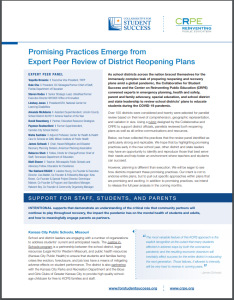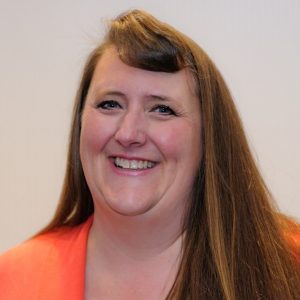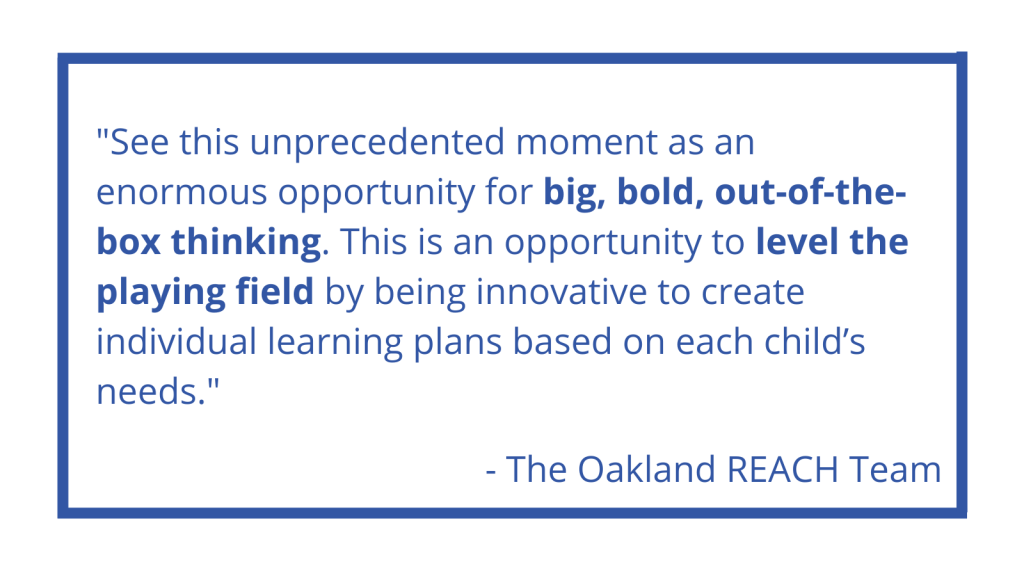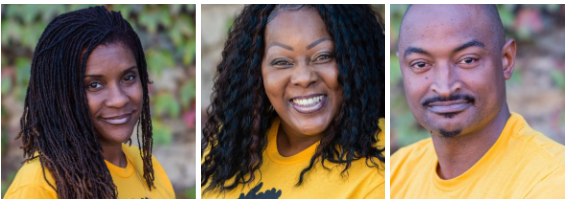COVID Slide Quicksheet Interview Series: Peer Reviewers Discuss Analyzing District Reopening and Recovery Plans


This summer, the Collaborative for Student Success teamed up with the Center on Reinventing Public Education to convene a panel of experts across the fields of disaster and emergency preparedness, family and student advocacy, education leadership, and health and safety to analyze the strength and quality of twenty district reopening plans, culled down from nearly a hundred plans based on level of comprehensiveness. The peers centered their analysis around a district planning rubric previously released by the Collaborative and CRPE, which included considerations for family-centered communications, effective supports for staff and students, a prioritization of equity, and of course, a thorough thinking through of health and safety protocols.
Recently, the peer panel released a brief highlighting some of the most promising practices they observed as they conducted their analysis. These twelve practices span nine districts and, hopefully, present possible solutions to problems likely being experienced by other districts as schools continue to haltingly start the school year.
To hear more about this peer review process, as well as hear more about ways schools can continue to creatively meet the needs of students, we (virtually) sat down with a few of the experts from the peer review panel: Dr. Amanda McAdams, Assistant Superintendent, Lincoln County School District #2 & 2011 Arizona Teacher of the Year; Matt Shaver, a teacher in Minneapolis Public Schools & Advocacy Fellow at Educators for Excellence; and three members of the Oakland REACH team, Co-founder & Executive Director Lakisha Young, Co-founder & Special Project Director Keta Brown, and Co-founder & Community Organizing Manager Hakeem Brown. This interview is part of a series produced for the Collaborative’s COVID Slide Quicksheet Newsletter, which you can sign up for here.
Collaborative for Student Success (CSS): Were there any stand-out policies or procedures that you want to make sure other districts and their leaders review and incorporate into their efforts?

Matt Shaver (MS): I appreciated the outreach that Miami-Dade did for its families. I liked Santa Ana’s differentiation plans for specialized populations. Kansas City had a solid outreach plan when students fall off the radar.
Dr. Amanda McAdams (AM): Besides the open survey to capture real time feedback, there are other things that stood out to me. I liked where districts provided videos for parents. There were videos on how to register electronically, how to log in supporting software, how to access Canvas, how to see what the scope and sequence for a certain class, etc. I really appreciated the one district that had an open budget session, presented possible expenditures for CARES Act monies, and took feedback from stakeholders. None of the districts I reviewed talked about staff daycare supports in case a daycare is closed temporarily due to Covid exposure.
Oakland REACH: First, how communication is provided to families and the community: it is crucial that schools need to use all forms of communication. ie. Twitter, Instagram, Facebook, email, text, newsletters, zoom meeting. We need to reach families where they are.
Second, we need to recognize that so many families don’t have a culture of learning in their homes – whether that means there is no computer and internet or even that parents received a failing education themselves and don’t have the skills they need to support their children. Districts need to be thinking about the whole family with their efforts. That’s why at The Oakland REACH, our Virtual Family Hub also provides a Family Liaison that helps parents with accessing their children’s coursework, accessing the quality of the learning, and advocating for a quality education.
CSS: What do you believe might be significant considerations or upcoming challenges for school districts? What do you believe they ought to be planning for in the coming months or years?

MS: Until we have a vaccine, districts will be challenged to maintain in-person learning. There are so many competing interests that will make it difficult to stay open for significant periods of time.
AM: Challenges will be how to manage remote teaching if a teacher is quarantined or isolated. There was not enough in the district plans about how to support staff and teachers. Our district is going to start training elementary teachers to build virtual courses. Although there is virtual curriculum available for purchase, we don’t want to sell someone else’s courses. Our teachers are going to start building (elementary…secondary has already built virtual courses) courses. We have never had to compete for students with other districts before, but now, with more virtual options popping up around the country and with more parents transitioning to working from home, we need to ensure that we can retain our students by offering a quality virtual product.
Oakland REACH: Black and Brown students have been in crisis learning for generations, way before the pandemic hit. We have to do things really differently to provide a quality education for ALL children. Stop lamenting about how hard this time is and get to work adjusting to the new reality with equity at the forefront.
Schools need to have a clear contingency plan for the future to make sure that all kids will continue to be in a safe environment while obtaining a quality education. There needs to be an intentional focus for underserved communities. We also need to recognize that computers, the internet, and desks are necessities, not luxuries, and make sure every home is equipped with the tools needed plus family support about how to use these tools.

Collaborative for Student Success (CSS): Based on your experience reviewing district plans, did they meet your initial expectations? Why or why not?
MS: I think districts were placed in an impossible situation by the fact that we don’t have a coherent national strategy to combat the virus. That trickles down to education where states are on their own often would leave districts on their own. I was disappointed to see that many districts seemed to have emphasized physical reopening logistics rather than tuning up and improving virtual learning. I think it is unrealistic for most districts to not expect to go to distance learning during the school year. It made me wonder how much districts understood about what didn’t work this spring and how they could potentially fix those challenges.

AM: I wasn’t sure what to expect on these plans until I started digging into my own state and district and then the rubric provided to us by the Collaborative. Some of the plans were really impressive given the time frame provided and so much uncertainty. Some districts really tried hard to survey stakeholders to get their input. Others provided videos and training so that people could get an idea of what reopening could look like.
The Oakland REACH: No, many lacked details and didn’t provide a clear, parent-friendly plan. It is so clear the need to involve more parents in the process – to give parents a seat at the table and involve their feedback and experiences in the decision-making process. Districts need to make decisions WITH parents not FOR parents.
CSS: After submitting your ratings, how do you personally feel about the state of reopening schools in the U.S.? ie. Did reviewing district plans inform your optimism or concern for how well schools will be able to overcome pandemic-related disruptions to facilitate learning?
MS: I am pessimistic about the viability of district plans to keep schools open throughout the winter. Not so much because district plans are going to cause significant spread of the virus but simply because we don’t have that national, multi-tiered approach to mitigating the impact of the virus. Had more districts assessed the situation and realized that at minimum, it’s likely there will be intermittent openings and closings throughout the country, they would have spent more time planning out how to improve distance learning rather than developing their best “hygiene theater” practices.

AM: Reopening is different all over the United States. In my small rural valley, we are so lucky to be able to open face to face. However, once we did, we still had to navigate positive tests from staff and students while still trying to remain open. Today marks the beginning of week 7 with live face to face instruction. We social distance and wear masks when we will be within six feet of either a student or staff member. Watching our small district meet with stakeholders, I was amazed at the number of things that needed to be addressed: from parking to volunteers to lunch to specials to sports. I can only imagine how these issues are magnified in an urban setting. I was very impressed with the level of detail in a few of the plans. Virtual learning at the secondary level seems to be much easier than at the elementary level.
Oakland REACH: Many schools didn’t have all the information they needed to provide a safe environment for kids to return to school. Schools were mostly focused on the pandemic vs. having a clear plan for ensuring the children were also being provided with a quality education. Some of the reviews appeared to be somewhat segregated – for example, once you made your choice of online or in-person, there appeared to be a lack of support based on the decision you made for your student. Reviewing district plans brought up more concerns about topics not discussed, including considerations for children with special needs, high-risk students, and children of color.
CSS: From the perspective of your field of expertise, do you have any general advice for district or school leaders based on your review?
MS: Listen to teachers as much as possible while balancing the needs of students and families. Do not try and precisely replicate the school day virtually. Focus on the essentials with academics and meeting the basic needs of students (food, technology, internet).
AM: My first piece of advice is to involve all stakeholders and do it often. Reach out to parents via surveys, cold calls, and visits where possible. Get teachers to join the conversation as their perspective is often key to early identification of possible obstacles. Continue with an open survey on your website or Facebook page where stakeholders can pose questions and make comments. Be transparent regarding any state funding.
Oakland REACH: See this unprecedented moment as an enormous opportunity for big, bold, out-of-the-box thinking. This is an opportunity to level the playing field by being innovative to create individual learning plans based on each child’s needs. That’s why The Oakland REACH used this time to launch a Virtual Family Hub focused on making parents savvy in virtual practices and leaders in their children’s education in a way they never have been before.
Based on the severity of the current situation of COVID in each area, leaders should also be building more partnerships with families and the community.
About the Collaborative for Student Success
At our core, we believe leaders at all levels have a role to play in ensuring success for K-12 students. From ensuring schools and teachers are equipped with the best materials to spotlighting the innovative and bold ways federal recovery dollars are being used to drive needed changes, the Collaborative for Student Success aims to inform and amplify policies making a difference for students and families.
To recover from the most disruptive event in the history of American public schools, states and districts are leveraging unprecedented resources to make sure classrooms are safe for learning, providing students and teachers with the high-quality instructional materials they deserve, and are rethinking how best to measure learning so supports are targeted where they’re needed most.

